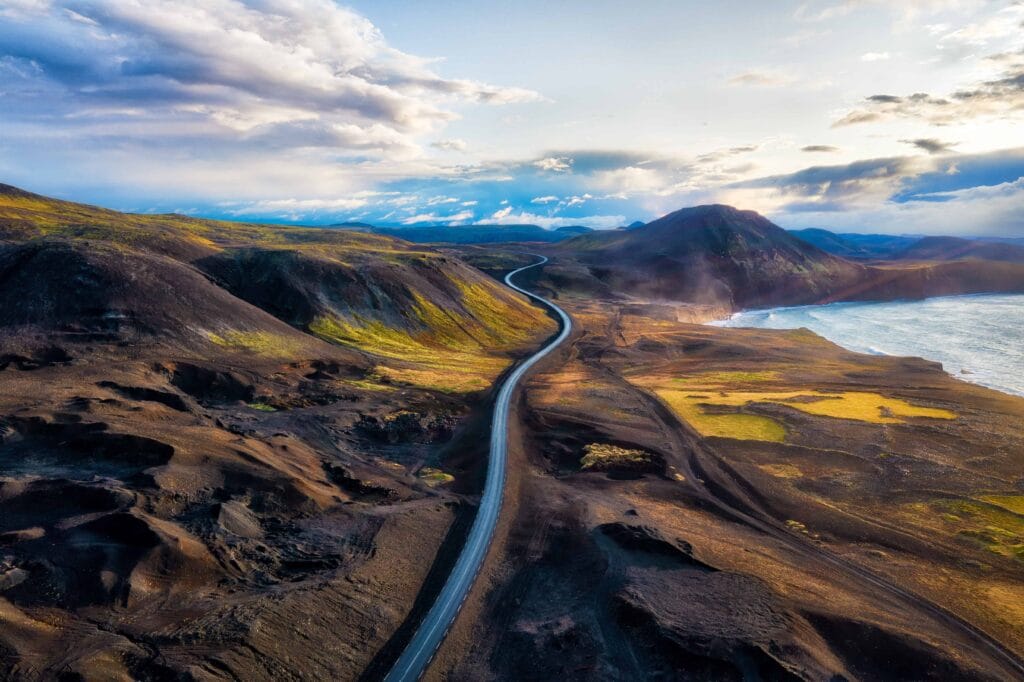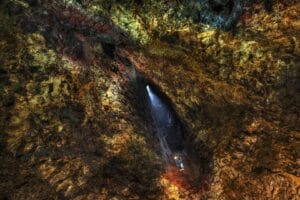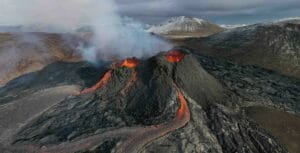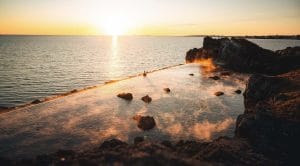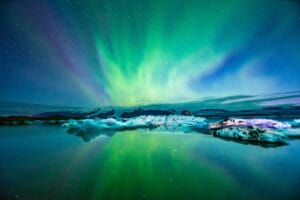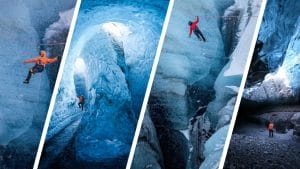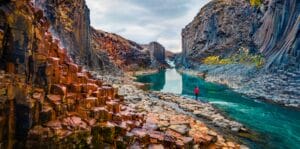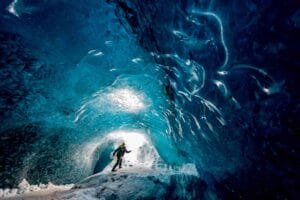Driving Iceland’s Ring Road (Route 1) is one of the most iconic road trips in the world. Circling the entire country, this 1,332-kilometer (828-mile) route takes travelers through a diverse array of landscapes, from cascading waterfalls and black sand beaches to steaming geothermal fields and majestic glaciers. The journey offers a unique opportunity to experience Iceland’s remote beauty, vibrant towns, and countless natural wonders.
Here’s a comprehensive guide to driving Iceland’s Ring Road, including essential tips, popular stops, seasonal considerations, and how to make the most of this incredible adventure.

Understanding the Ring Road: An Overview
The Ring Road (Route 1) is Iceland’s main highway, encircling the country and connecting many of its most famous sights. While you could theoretically drive the Ring Road in 24 hours, it’s recommended to plan at least 7-10 days to fully appreciate the journey and enjoy the sights along the way. Most of the road is paved and accessible by a standard vehicle, but certain sections can be affected by weather conditions, especially in winter.
Distance: 1,332 kilometers (828 miles)
Recommended Duration: 7-10 days
Vehicle Requirements: Standard car for summer, 4×4 for winter recommended
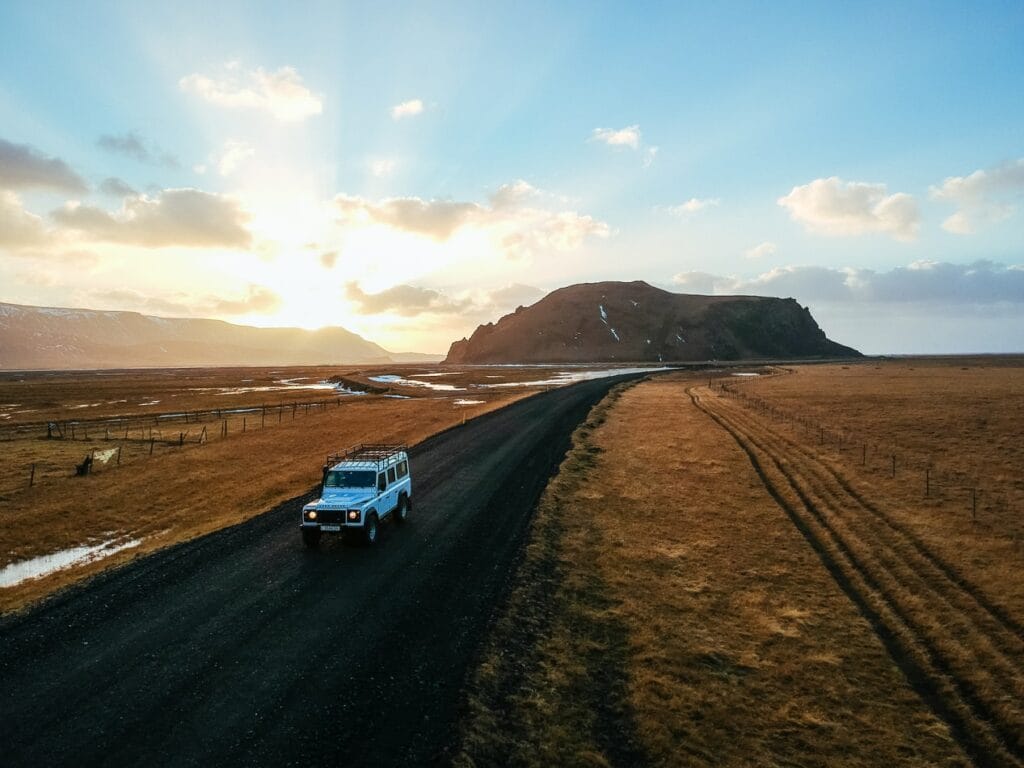
Preparing for Your Ring Road Adventure
Car Rental
Most visitors rent a car or campervan to drive the Ring Road. For summer trips, a standard car is generally sufficient, but in winter (October to April), it’s highly recommended to rent a 4×4 for added stability on potentially icy roads. Book your rental in advance, especially during peak season (June to August), to secure your preferred vehicle.
Packing Essentials
Icelandic weather is famously unpredictable, so packing smart is essential. Key items include:
- Layered Clothing: Waterproof and windproof layers, warm base layers, and wool socks.
- Navigation Tools: A GPS or offline map, as some remote areas may lack cell service.
- Food and Water Supplies: Some stretches are remote, so having snacks and water is helpful.
- Emergency Gear: First aid kit, flashlight, extra fuel can, and blankets, especially in winter.
Weather Considerations
Weather in Iceland can vary significantly by region, even within a single day. Winter travel requires caution, as roads may close temporarily due to snow and ice. Always check road.is for real-time road conditions and vedur.is for weather updates.
Highlights of the Ring Road: Must-See Stops
The Ring Road is filled with iconic and lesser-known attractions. Here’s a breakdown of top stops along the route:
South Iceland
Reykjavik: Start your journey in Iceland’s capital, where you can explore cultural sites like Hallgrímskirkja Church, Harpa Concert Hall, and local shops and cafes. Stock up on essentials here before heading out.
Seljalandsfoss and Skógafoss: Two of Iceland’s most famous waterfalls, both located along the southern coast. Seljalandsfoss offers the unique experience of walking behind the falls, while Skógafoss is a powerful 60-meter drop that creates beautiful rainbows on sunny days.
Reynisfjara Black Sand Beach: Near the village of Vík, this beach is known for its jet-black sands, basalt columns, and roaring Atlantic waves. Marvel at the sea stacks and take caution, as the waves can be unpredictable.
Fjaðrárgljúfur Canyon: This stunning canyon near Kirkjubæjarklaustur is often missed, but its winding river and green cliffs make it a scenic spot for a hike.
Jökulsárlón Glacier Lagoon and Diamond Beach: Located near Vatnajökull National Park, Jökulsárlón is a glacial lagoon filled with floating icebergs. Across the road, Diamond Beach features ice chunks washed up on black sand, creating an otherworldly sight.
East Iceland
6. Höfn: This charming fishing town is famous for its fresh langoustine and scenic harbor views. It’s a great stop for a seafood meal and to enjoy views of Vatnajökull Glacier in the distance.
7. Djúpivogur: A small coastal town with a relaxed vibe, Djúpivogur offers art installations like Eggin í Gleðivík and views of the surrounding fjords.
8. East Fjords: The winding road through Iceland’s East Fjords provides breathtaking views of remote fjords, coastal cliffs, and charming fishing villages. Highlights include Stöðvarfjörður and Seyðisfjörður, each with unique culture and history.
North Iceland
9. Dettifoss: Known as Europe’s most powerful waterfall, Dettifoss is a stunning sight with its thundering cascade into the Jökulsárgljúfur canyon. It’s accessible via a gravel road, so be cautious in winter.
10. Lake Mývatn: A geothermal wonderland, Lake Mývatn offers unique attractions like Dimmuborgir lava fields, Hverir geothermal area, and the Mývatn Nature Baths, an alternative to the Blue Lagoon with stunning views over the lake.
11. Húsavík: Often called the “Whale Watching Capital of Iceland,” Húsavík offers boat tours where you can see minke and humpback whales. The town also has a charming harbor and whale museum.
12. Akureyri: Iceland’s “Capital of the North,” Akureyri is a vibrant town with cultural attractions, including the Akureyri Art Museum, botanical gardens, and a variety of cafes and restaurants.
West Iceland
13. Hvítserkur: This 15-meter-high basalt sea stack resembles a dragon drinking from the ocean and is located on the Vatnsnes Peninsula. It’s a short detour from the main Ring Road.
14. Snæfellsnes Peninsula (Optional): While not directly on the Ring Road, the Snæfellsnes Peninsula is a worthwhile detour. Highlights include Kirkjufell Mountain, Arnarstapi, and Snæfellsjökull National Park.
15. Borgarfjörður: Home to the Hraunfossar and Barnafoss waterfalls, as well as the Deildartunguhver hot spring, the Borgarfjörður region offers beautiful nature and is located a short drive from Reykjavik.
Driving Tips for the Ring Road
Speed Limits: The speed limit on the Ring Road is typically 90 km/h (55 mph) on paved sections and 80 km/h (50 mph) on gravel roads. Speeding fines are high, so adhere to posted limits.
Single-Lane Bridges: Many bridges along the Ring Road are single-lane, so approach carefully and yield to oncoming traffic.
Sheep and Wildlife: In summer, sheep often graze near the roadside, and it’s not uncommon for them to wander onto the road. Slow down if you see animals nearby.
Fuel: Some sections of the Ring Road are remote, with limited fuel stations. Keep your tank at least half full, especially when driving through East and North Iceland.
Weather Awareness: Iceland’s weather changes rapidly, so check forecasts regularly. Wind, ice, and fog can affect driving conditions, particularly in winter. If weather worsens, pull over in a safe spot or find the nearest town until conditions improve.

Seasonal Considerations for Ring Road Travel
The time of year you choose to drive the Ring Road significantly impacts your experience. Here’s what to expect by season:
Summer (June to August): Summer offers long daylight hours, warmer temperatures, and fully accessible roads. This is peak season, so expect more tourists, but it’s the best time for an easygoing Ring Road experience.
Autumn (September to October): Early autumn provides mild weather, beautiful fall colors, and fewer crowds. Daylight hours shorten, so plan to cover shorter distances each day.
Winter (November to March): Winter brings snow, ice, and limited daylight. Driving conditions are more challenging, with potential road closures, especially in North and East Iceland. A 4×4 vehicle is recommended. Winter travelers are rewarded with snowy landscapes and Northern Lights viewing opportunities.
Spring (April to May): In spring, snow begins to melt, and roads become more accessible. It’s a quieter time to travel with fewer tourists and increasing daylight, but be prepared for some lingering winter conditions, especially in the north.
Alternative Routes and Extensions
While the Ring Road itself is packed with must-see destinations, some visitors choose to extend their trip with additional routes:
Snæfellsnes Peninsula: Known as “Iceland in Miniature,” Snæfellsnes has volcanoes, waterfalls, black sand beaches, and the Snæfellsjökull glacier. It’s a 1-2 day detour that’s worth every moment.
The Golden Circle: While technically not on the Ring Road, the Golden Circle route is an easy addition. It includes Þingvellir National Park, Geysir geothermal area, and Gullfoss waterfall. Many travelers visit the Golden Circle before starting the Ring Road journey.
The Westfjords: Iceland’s least-traveled region, the Westfjords is a wild and rugged area of fjords, cliffs, and waterfalls. It’s a significant detour, but perfect for those looking to experience Iceland off the beaten path.
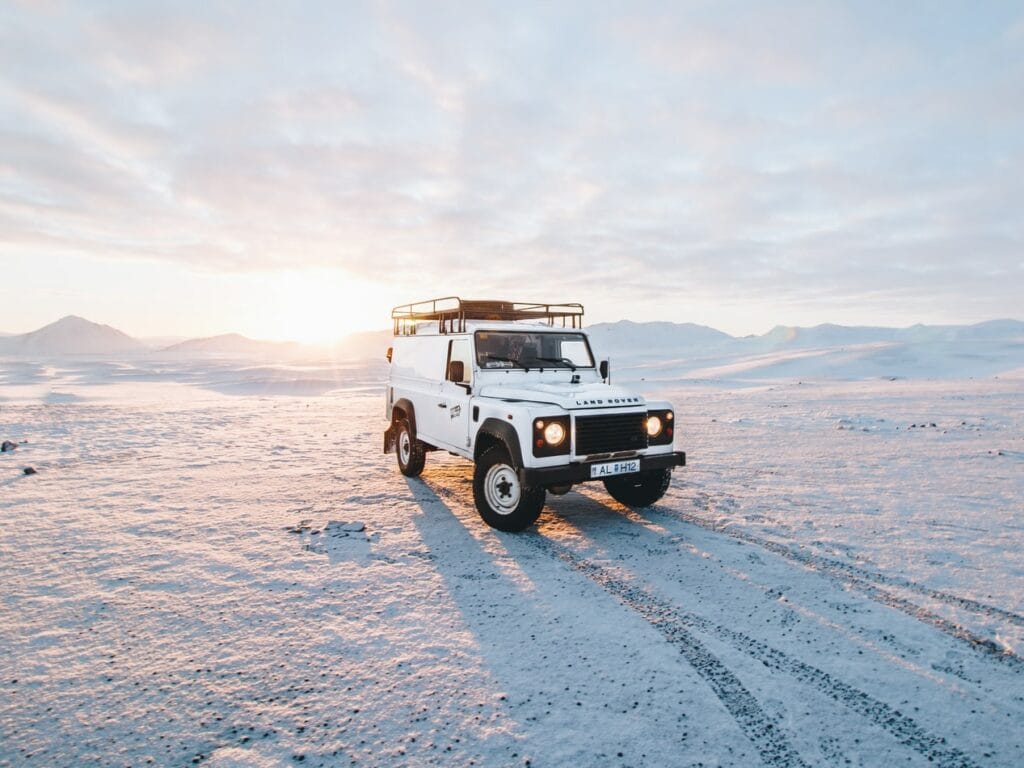
Budgeting for the Ring Road
Driving the Ring Road requires budgeting for car rental, fuel, accommodations, food, and activities. Here are some budgeting tips:
- Accommodations: Budget options include guesthouses, hostels, and camping (in summer). Booking in advance is crucial in peak season.
- Food: Eating out can be expensive, so consider cooking some meals if your accommodations have kitchen facilities. Grocery stores like Bonus and Krónan are affordable.
- Fuel Costs: Iceland’s fuel prices are high, so plan accordingly. Consider downloading a fuel station app to find nearby gas stations.
- Tours and Activities: Popular activities along the Ring Road include glacier hikes, whale watching, and Northern Lights tours in winter. Pre-booking these activities is recommended, especially in peak season.
What to Be Aware of When Driving the Ring Road
Driving Iceland’s Ring Road is an unforgettable experience, but it requires awareness of unique challenges and road conditions. Here’s what to keep in mind for a safe and smooth journey:
1. Road Conditions and Weather
- Unpredictable Weather: Icelandic weather is famously unpredictable, with conditions that can change rapidly. It’s common to experience sun, rain, snow, and high winds within a single day. Always check the Icelandic Road and Coastal Administration website (road.is) for real-time road conditions and vedur.is for weather updates.
- Winter Road Closures: During winter, certain sections, especially in North and East Iceland, may close temporarily due to snow and ice. Roads may reopen within hours, but it’s essential to stay updated.
- Icy and Slippery Roads: Ice is common in winter, even on paved sections. Always drive cautiously and avoid sudden movements. Use low gears on downhill sections to prevent sliding.
- Single-Lane Bridges: The Ring Road has several single-lane bridges, requiring drivers to yield to oncoming traffic. Check for approaching vehicles and always slow down before crossing.
- Gravel Roads: Although most of the Ring Road is paved, there are sections with gravel, particularly in remote areas. Reduce speed on gravel to avoid skidding, and be cautious of loose stones that may cause damage.
2. Fueling Up
- Limited Fuel Stations: Some sections, particularly in the East and North, have long stretches without fuel stations. Keep your tank at least half full, especially when approaching remote areas.
- Payment at Fuel Stations: Many fuel stations in Iceland are self-service and may require a credit or debit card with a PIN. Plan to have a card with you that works internationally.
3. Wildlife Hazards
- Sheep on the Roads: Sheep graze near the roads, particularly in summer, and they often wander onto the Ring Road. Slow down if you see sheep near the road, as they may dart into your path.
- Birds and Other Animals: Iceland’s wildlife can include birds on the road, particularly near coastal areas. Keep an eye out and avoid swerving, as this can be more dangerous than slowing down carefully.
4. Driving Etiquette and Rules
- Speed Limits: The speed limit on paved sections is generally 90 km/h (55 mph) and 80 km/h (50 mph) on gravel roads. Speeding fines are steep in Iceland, and traffic cameras monitor sections of the Ring Road.
- Headlights: Keep your headlights on at all times, day and night. This is mandatory in Iceland and helps increase visibility in changing weather.
- Avoid Off-Road Driving: Off-road driving is illegal in Iceland due to the country’s delicate landscapes. Stay on designated roads and trails at all times.
- Emergency Preparedness: In case of breakdowns or emergencies, have emergency numbers on hand. Iceland’s emergency number is 112. Many car rental companies provide a phone number for roadside assistance as well.
5. Respecting Nature and Conservation Efforts
- Iceland’s landscapes are fragile, so it’s essential to leave no trace and respect nature. Stick to marked paths and avoid disturbing vegetation. Iceland’s authorities strictly enforce conservation laws to protect the environment.
Being mindful of these tips will ensure a safer, more enjoyable journey around the Ring Road, allowing you to fully experience the beauty of Iceland without unnecessary risks.

Adding the Golden Circle and Snæfellsnes Peninsula to Your Ring Road Trip
If you have a few extra days, consider enhancing your Ring Road adventure by adding the Golden Circle and Snæfellsnes Peninsula to your itinerary. Both regions offer unique sights and experiences, making them worthwhile additions to a self-drive tour of Iceland.
1. The Golden Circle
The Golden Circle is a popular route near Reykjavik, featuring three iconic destinations: Þingvellir National Park, the Geysir Geothermal Area, and Gullfoss Waterfall. This route is only a short detour from the Ring Road and offers a variety of attractions.
- Þingvellir National Park: A UNESCO World Heritage site, Þingvellir is famous for its historical significance as the site of Iceland’s ancient parliament and its geological beauty. Located in a rift valley between the North American and Eurasian tectonic plates, it’s a great spot for hiking and photography.
- Geysir Geothermal Area: Home to the famous “Geysir” (the origin of the word “geyser”), this area has active hot springs, including Strokkur, which erupts every few minutes. It’s a fantastic sight and an iconic Icelandic experience.
- Gullfoss Waterfall: Often referred to as the “Golden Waterfall,” Gullfoss is a two-tiered cascade that plummets into a deep canyon. In winter, parts of Gullfoss freeze, creating a dramatic and beautiful scene.
Adding Time: The Golden Circle is easily accessible from Reykjavik and can be explored in a day. Many travelers start with the Golden Circle and then join the Ring Road.
2. Snæfellsnes Peninsula
Known as “Iceland in Miniature,” the Snæfellsnes Peninsula is located to the west of the Ring Road and showcases a diverse range of landscapes. From glaciers and mountains to black sand beaches and fishing villages, Snæfellsnes offers a taste of Iceland’s natural beauty on a smaller scale.
- Kirkjufell Mountain and Kirkjufellsfoss Waterfall: Kirkjufell, with its striking shape, is one of the most photographed mountains in Iceland. Combined with the nearby Kirkjufellsfoss waterfall, it’s a must-visit for photographers and nature lovers.
- Snæfellsjökull National Park: Dominated by the Snæfellsjökull glacier-volcano, this national park is a highlight of the peninsula. The glacier is often visible from Reykjavik on a clear day and offers hiking, caves, and stunning views.
- Arnarstapi and Hellnar: These quaint fishing villages are known for their dramatic coastal cliffs, sea arches, and birdlife. A scenic walking trail connects the two, offering spectacular views of the coastline.
- Djúpalónssandur Black Sand Beach: This pebble beach has unique rock formations, remnants of a shipwreck, and stunning ocean views. It’s a fascinating place to explore and take photos.
- Búðir Church: The iconic black church at Búðir stands in stark contrast to the surrounding lava fields. It’s a popular photography spot and a peaceful location for reflection.
Adding Time: The Snæfellsnes Peninsula can be explored in one or two days, depending on your pace. It’s a detour from the Ring Road but offers a quieter, scenic escape with plenty to see.
Why Include the Golden Circle and Snæfellsnes Peninsula?
Adding these regions to your Ring Road itinerary enhances your trip with unique Icelandic experiences that you won’t find elsewhere. The Golden Circle offers historical and geological highlights that provide insight into Iceland’s natural and cultural heritage, while the Snæfellsnes Peninsula is a microcosm of Iceland’s diverse landscapes.
By including both the Golden Circle and Snæfellsnes Peninsula, you’ll create a more comprehensive and immersive journey that covers a wide array of Iceland’s natural wonders. These detours allow for a richer experience, whether you’re interested in waterfalls, geological formations, or Icelandic folklore.
Conclusion: Why Drive the Ring Road?
Driving the Ring Road is the ultimate Icelandic adventure, offering an intimate look at the country’s natural wonders, vibrant towns, and awe-inspiring landscapes. This journey rewards travelers with waterfalls, glaciers, volcanoes, and unforgettable memories. With careful planning, the Ring Road can be a safe, enjoyable, and incredibly rewarding experience, whether you’re seeking adventure or simply the beauty of Iceland’s remote wilderness.
Embark on this epic journey around Iceland, and prepare for an adventure that you’ll remember for a lifetime.

It is simply a road hazard to park on the highway for any reason whatsoever. Let us say that you were driving by peacefully, blasting your jam, dancing to the tunes, and then you suddenly spot some beautiful Icelandic horses on the private farm on the side of the road. What should be your next course of action? Should you just park on the road and take a few pictures with the horse. No. You need to drive and find a place on the side-lines to park your car, preferably near the farm itself, and then take the permission of the owner before finally approaching the horses. In any scenario, do not park the car on the highway as this is the main route that connects all the country so, naturally it sees a lot of cars, driven at a speed of 70-90 kilometers/hour. It is simply dangerous for both your parked vehicle and the oncoming ones.
Speeding is NOT Appreciated or Tolerated
Over-speeding is not a good idea, no matter the place concerned. Not only that it is unsafe, but it also comes with quite a hefty fine, according to the standards of the place. Iceland, for one, is very strict about speed limits. There are three kinds of roads in the country and the speeding limit is set according to the type of road. The ring road is a paved road that has a set speed limit of 90 kilometers/hour, also the highest speed limit allowed anywhere in Iceland. There are speed cameras at close distances all over the road so ensure that you stay within the limit to avoid the fine.
Traffic Laws
Apart from the speed limits, wearing the seatbelt, and driving on the right side of the road, there are a few other things that one must take care of. It is mandatory to keep the headlights switched on at all times when driving in Iceland, on or off the ring road. Older children sitting in the rear seat must wear seat belts while the younger ones must be put into a car seat. Needless to say, driving under the influence and using mobile phones when driving is prohibited in Iceland. A DUI will get you a fine of a minimum of 100,000 ISK along with a 4-month-long suspension of driving privileges. Roundabout traffic priority is given to the vehicles on the inner lane so ensure that you follow the priority rules when crossing roundabouts.
Keep Track of the Emergency Helplines
The national emergency helpline is 112. You can call it anytime, from anywhere, and be assured that help will arrive. Be it fire, theft, an accident on the road, a crime scene, a rescue call, or natural disasters, the 112 helpline is open for all kinds of emergencies that people in Iceland face. Know that it could take some time for help to arrive. The helpline is reachable via text, call, or voice messages.
Another option that you have is installing the 112 Iceland app. The app can help you in searching for routes and such and will also keep you updated about any possible mess-ups along the route, stops that you can make, etc.
General emergencies like the breaking down of vehicles can be dealt with by calling your rental agency. They will send along with the necessary help. In the meantime, stay beside your car and wait for help to arrive. If the problem is something as simple as a flat tire and can be solved by a second or third-hand on-board, try asking fellow passers-by for help. No matter what you do, do not leave your vehicle unattended in the middle of nowhere.
Extreme Weather Conditions are A Thing
Never let go of the possibility that weather can change in a matter of seconds in Iceland. It could be all sunny and pretty when you set out in the morning at 7 and it may start at 8. Extreme weather changes and conditions are common in Iceland so always be prepared for them. Keep a snow shovel handy if you have to – better be prepared than sorry after all.
